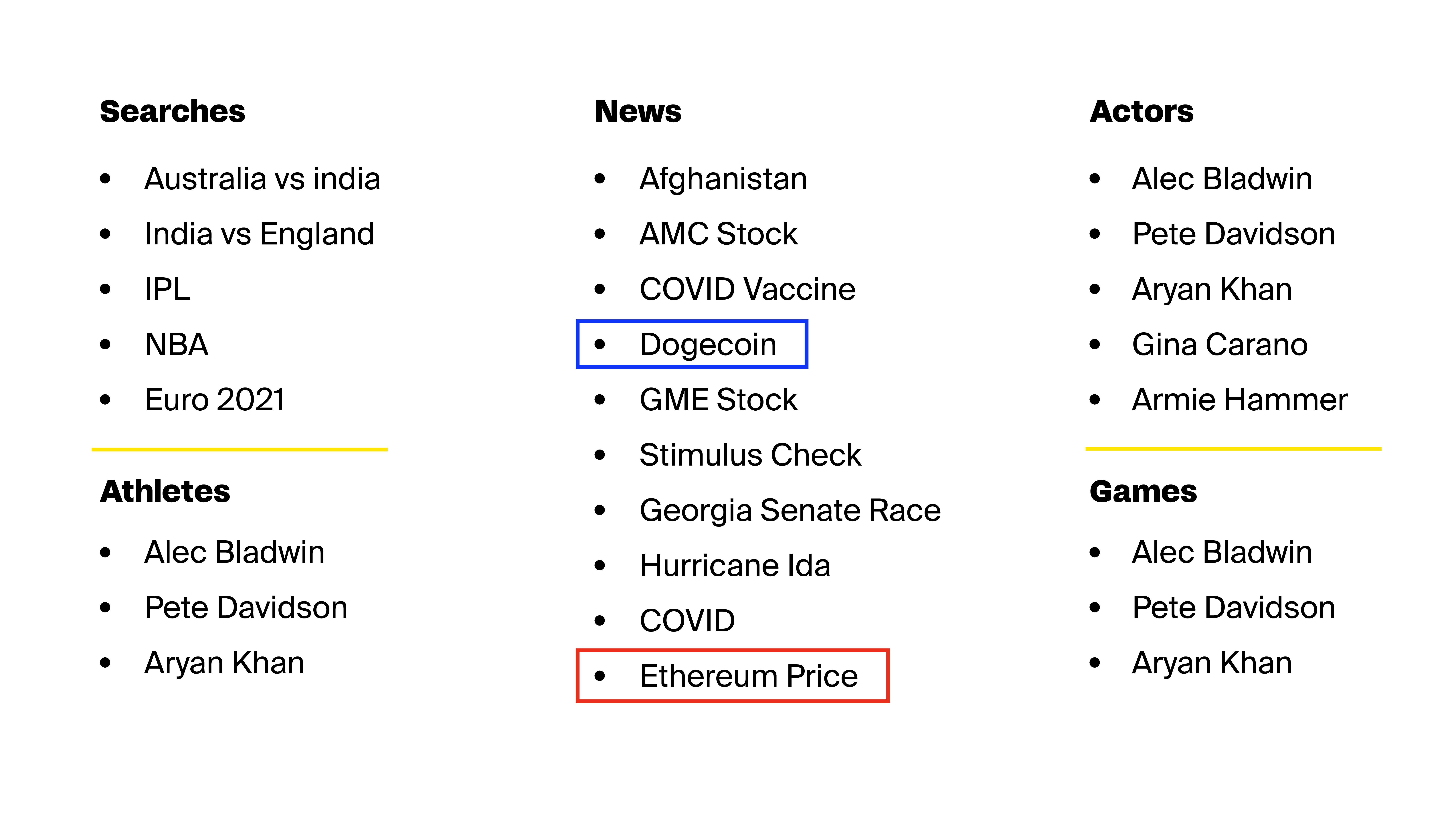After the year we had, ecommerce trends for 2022 are going to be a bit different than before. Vaccine rollouts, new variants, a teeter-tottering economy, the metaverse, blockchains… 2021 has been one roller coaster of a year! However, when it comes to e-commerce & online retail, there’s one thing that hasn’t changed and isn’t changing anytime soon. More customers are shopping online than ever before.
With this continued increase in online shopping demand, comes a desire to enhance the shopping experience. In 2022, brands & retailers must embrace technological advances if they wish to stay competitive. Here are the 10 e-commerce trends for 2022 we will see dominating the space.
eCommerce Trends for 2022:
Now, let’s get into these eCommerce trends for 2022 to identify how your brand or store can leverage them for growth.
#1: The Year of Cryptocurrency
Cryptocurrency isn’t anything new. However, it’s more popular than ever. Web3 searches increased more than ever with Ethereum and Dogecoin landing on the top 10 Google News searches for 2021.
Why does this matter for e-commerce retailers? With many users seeing large profits in their crypto wallets, they want to be able to use these funds without transferring them into their bank accounts. This means retailers need to provide ways these customers can purchase items with said funds.
More than just being a one-sided benefit to customers, accepting Cryptocurrency on e-commerce sites brings with it upsides for retailers as well. Not only will this allow retailers to broaden their reach to a new demographic, but it also provides instant payments that don’t take days to process from the bank. Additionally, credit card processors usually take 5-10% of each sale. Fees are much, much lower when you are accepting Cryptocurrency.
Accepting Cryptocurrency is a win-win for retailers and customers alike.
#2: Transitioning to the Metaverse
Much like Cryptocurrency, other buzzwords we saw gaining momentum in 2021 were NFTs and the Metaverse. After Meta, formerly Facebook, announced its rebrand in late 2021, retailers started finding ways they too could pivot their strategies to enter the Metaverse. In mid-December, Nike acquired RTFKT, a leader in delivering collectibles that fuse together both gaming and culture. RTFKT develops the latest in gaming, NFTs, blockchain authentications, and AR to produce unique virtual experiences along with products for use within those experiences.
While Nike has not released their plans, we can imagine they will begin retailing their products developed by RTFKT in the Metaverse in the coming months. Other brands should take note and find ways they could pivot their strategies to leverage growth within the Metaverse in 2022.
#3: Community-Led Growth
Within 2022’s upcoming trends such as Cryptocurrency and the Metaverse, there’s a new marketing channel brands need to embrace: their communities.
As these new technologies gain mass attention, they bring with them a level of confusion. Thus, users are turning to brands fostering communities to help ease confusion and learn more about these types of products.
This desire for users to gain access to information also translates into commerce as well. According to buySAFE, 81% of customers feel concerned when shopping with an unfamiliar retailer. Retailers who embrace User Generated Content (UGC) are able to see increased engagement on site. The data proves it. According to an article from Shortstack, 93% of consumers say UGC is helpful when they’re making purchase decisions. Plus, UGC campaigns bring 29% higher conversions than those without them.
In short, customers want to see what products look like on real people. In order to obtain & leverage this User Generated Content, brands need to embrace their community’s content. They also need to find engaging ways to communicate with these said users.
In 2022, this is something retailers will have to implement if they want to gain the trust of their consumers & stay competitive within the marketplace.
#4: AI for More Personalized Experiences
When one thinks of Artificial Intelligence in e-commerce, most marketers think about analytics and campaign optimizations. However, companies in the e-commerce space have taken AI to the next level. With consumers shopping online more than ever, it’s imperative users get provided a new and personalized experience with each visit. Companies like Nosto have leveraged this by developing solutions to deliver these types of customized experiences.
Nosto’s Case Study for the brand Bandier proves the success an e-commerce retailer can see from such implementations. The challenge Bandier faced is what we call the burden of choice; customers were seeing so many options, it was overwhelming.
The solution implemented was unique product recommendations to each customer based on data from various A/B tests on top pages. The results on Bandier’s homepage alone led to a 2% increase in overall revenue, 10.5% higher AOV, and 8.5% higher revenue per visit.
What can we learn from this case study? Users want fresh, personalized experiences directly related to their search and site behavior. They want to find what they’re looking for quickly & easily. AI merchandising in e-commerce does just that.
#5: AR as a Safer (And More Convenient) Way to Shop
If there’s one thing retailers learned from the COVID-19 pandemic, it’s that being able to pivot your current strategy is integral for success. When people began to spend more and more time at home working, working out, homeschooling, etc, it was realized that home is more important than ever. Data available from Comscore Plan Metrix Multi-Platform showed us that in August 2020, 74.2 million consumers participated in some form of a home remodel. A 20% increase from the year prior. From a retail perspective, furniture sales boomed as a result of this newfound interest in the home space.
Luckily for Wayfair, they had already implemented AR technology into their app to allow users to see what a particular piece would look like in their home. They did so 2 years prior to the pandemic. This gave them a competitive advantage over their competitors. Customers no longer needed to go in-store to see the dimensions of the products or visualize how they would look in their homes.
Other retailers have taken a page out of Wayfair’s book. Sephora recently launched in-app AR. Their technology allows customers to sample products without needing to go in-store, take off their masks, and apply some of a sample that other people have already used. And that’s if the retailer is even offering in-store samples. For makeup enthusiasts, Sephora’s AR technology offered a much safer way to shop.
Social & Omnichannel Commerce
Maybe you’ve got a notification from Instagram you’re eligible for 20% off your first order when you checkout through the app. Yep, that’s right, Instagram now offers in-app checkout without having to exit the app. This is an example of social & omnichannel commerce.
Diversifying how customers interact with your brand is imperative in 2022. Consumers no longer want to leave an app where they saw an ad due to trust & security issues. Bloomberg predicts social shopping to hit $1.2 trillion by 2025. Brands need to pivot quickly if they’d like to leverage this increase in interest.
Instagram isn’t the only platform considered omnichannel commerce. Amazon is the top player in this diversification model. Offering your products on your website in tandem with multiple platforms like Amazon, Instagram, Google Shopping, etc gives more visibility to your brand. It also broadens your reach to users who opt to shop on those platforms. Getting set up on these platforms is fairly simple as well! Although you have to forfeit a portion of your sale to the platform, you’re reaching far more users than you would otherwise.
#7: Gamification to Stimulate Users
With the number of pop-ups, ads, videos, and more, it’s become increasingly difficult for brands and retailers to engage with potential customers. However, one small tweak to websites has proven to be effective in grabbing the attention of users: gamification. According to Zichermann and Cunningham, “Gamification is the art of applying game thinking and game mechanics in the non-game contexts to influence behavior.”
A common example of gamification is the “Spin the Wheel” welcome pop-up. These offer users a chance to receive a variety of different welcome offers, and they work. Popular gamification company, Just Uno, has provided incredible results to their customers. Pura Vida Bracelets is the perfect example.
Pura Vida increased their email capture by 150% from implementing Just Uno’s Spin the Wheel app on their website. From this increase in emails captured, they were able to increase conversions by 164%. Moral of the story: out with boring pop-ups and in with gamification!
#8: Easy Returns Process as a Competitive Edge
While most e-commerce companies opt to make the returns process a headache or not even offer returns in an effort to squeeze profits, an easy returns process actually gives brands an edge over their competitors. 42% of consumers noted a negative returns experience led to them never shopping with a company again, according to research from Optoro.
As we see more and more customers opting for online shopping, now more than ever brands need to embrace the returns experience. Returns can be a great opportunity to increase customer loyalty. As we’ve noted previously, community-led growth is an important marketing channel for brands, and it stems from customer loyalty.
In 2022, retailers and brands need to rethink their returns policy and ensure it aligns with current customer values.
#9: On-Device Authentication
If there’s one trend we see in consumers, it’s how frustrated they are with passwords. It seems every e-commerce site requires a password, some with more requirements than others. In an effort to make this easier, many customers are saving passwords to their web browsers. This makes them very vulnerable to hackers. In 2022, we will see the death of passwords with more and more retailers embracing on-device authentication.
Mastercard published a report in 2020 where they predicted biometric authentication transactions will account for $2 trillion in mobile shopping & banking transactions by 2023. In 2018, this only accounted for $124 billion in transactions.
68% of consumers say they would prefer fingerprint or facial recognition in lieu of two-factor authentication. 60% of consumers also said they feel retailers who implement these types of authentication care more about the customer experience, according to research by FIDO.
In case you haven’t noticed, in 2022 consumers want a faster & easier shopping experience and will be flexing their power with their wallets this upcoming year.
#10: Sustainability as a Value Proposition
COVID-19 highlighted not only how important our health is, but also the health of the entire world. In 2020, Carbon Dioxide Emissions decreased by 5.4%, a significant decrease due to lockdowns and quarantines. The world became hyper-aware of how everyday things can impact the environment. Consumers became more conscious than ever before. This means brands need to take note in order to serve these consumers. After all, they make up a large portion of the market.
According to a Forrester survey, “Nearly two-thirds (63%) of Progressive Pioneers will choose brands that help their local communities, while 57% intend to buy from companies that contribute to sustainability more frequently over the next two years.” Additionally the Gen-Z demographic as a whole is willing to spend more money on sustainable brands & products than their Millennial & Gen X counterparts.
That means more than half of consumers are looking for green, eco-friendly brands in an effort to decrease their own personal carbon footprints. If brands don’t do their part to reduce their carbon footprint or offer more sustainable products, they will be left behind in 2022.
—————————-
While we may not be fortune-tellers, we are data scientists constantly analyzing the marketplace. In fact, that’s how we predicted these eCommerce trends for 2022!
If you’d like to learn more about data science or how to stay on top of trends for your industry, subscribe to our newsletter!








